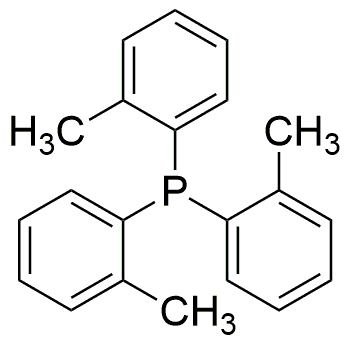Tri(o-tolyl)phosphine is widely utilized in research focused on:
- Catalysis: This compound serves as an effective ligand in various catalytic processes, particularly in transition metal-catalyzed reactions, enhancing reaction rates and selectivity.
- Organic Synthesis: It is commonly used in the synthesis of complex organic molecules, providing a versatile tool for chemists in pharmaceutical and materials science industries.
- Phosphine Chemistry: As a phosphine derivative, it plays a crucial role in the development of new phosphine-based reagents, which are essential in organic and inorganic synthesis.
- Material Science: It is utilized in the development of advanced materials, particularly in the production of polymers and nanomaterials, offering improved properties over traditional compounds.
- Research and Development: The compound is valuable in academic and industrial research settings, facilitating the exploration of new chemical pathways and reactions, thus driving innovation.
General Information
Properties
Safety and Regulations
Applications
Tri(o-tolyl)phosphine is widely utilized in research focused on:
- Catalysis: This compound serves as an effective ligand in various catalytic processes, particularly in transition metal-catalyzed reactions, enhancing reaction rates and selectivity.
- Organic Synthesis: It is commonly used in the synthesis of complex organic molecules, providing a versatile tool for chemists in pharmaceutical and materials science industries.
- Phosphine Chemistry: As a phosphine derivative, it plays a crucial role in the development of new phosphine-based reagents, which are essential in organic and inorganic synthesis.
- Material Science: It is utilized in the development of advanced materials, particularly in the production of polymers and nanomaterials, offering improved properties over traditional compounds.
- Research and Development: The compound is valuable in academic and industrial research settings, facilitating the exploration of new chemical pathways and reactions, thus driving innovation.
Documents
Safety Data Sheets (SDS)
The SDS provides comprehensive safety information on handling, storage, and disposal of the product.
Product Specification (PS)
The PS provides a comprehensive breakdown of the product’s properties, including chemical composition, physical state, purity, and storage requirements. It also details acceptable quality ranges and the product's intended applications.
Certificates of Analysis (COA)
Search for Certificates of Analysis (COA) by entering the products Lot Number. Lot and Batch Numbers can be found on a product’s label following the words ‘Lot’ or ‘Batch’.
Numéro de catalogue
Numéro de lot/série
Certificates Of Origin (COO)
This COO confirms the country where the product was manufactured, and also details the materials and components used in it and whether it is derived from natural, synthetic, or other specific sources. This certificate may be required for customs, trade, and regulatory compliance.
Numéro de catalogue
Numéro de lot/série
Safety Data Sheets (SDS)
The SDS provides comprehensive safety information on handling, storage, and disposal of the product.
DownloadProduct Specification (PS)
The PS provides a comprehensive breakdown of the product’s properties, including chemical composition, physical state, purity, and storage requirements. It also details acceptable quality ranges and the product's intended applications.
DownloadCertificates of Analysis (COA)
Search for Certificates of Analysis (COA) by entering the products Lot Number. Lot and Batch Numbers can be found on a product’s label following the words ‘Lot’ or ‘Batch’.
Numéro de catalogue
Numéro de lot/série
Certificates Of Origin (COO)
This COO confirms the country where the product was manufactured, and also details the materials and components used in it and whether it is derived from natural, synthetic, or other specific sources. This certificate may be required for customs, trade, and regulatory compliance.


